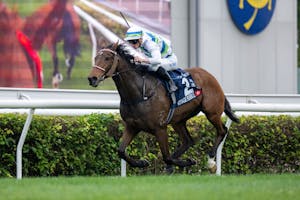Tall Tales of the Track: Donau Doesn’t Play

1910 Kentucky Derby Winner Donau
Every Kentucky Derby winner leaves their mark on the race, a collection of 150 stories writing the history of this sporting institution. One particular winner, Donau, came to Louisville with a colorful background and an even more colorful personality, his tale one of a champion with an attitude all his own.
Donau was not a horse one could pet. Foaled at Thomas Piatt’s Brookdale Farm, the bay colt was not savage as much as he was “a veritable bulldog,” as described in a May 1910 Daily Racing Form article.
“He did not like to have the other colts about him,” Piatt shared. “[He] would use his heels whenever they came near him.”
While his attitude might have been standoffish, his pedigree promised a durability that became his trademark. His sire Woolsthorpe, son of 1846 Two Thousand Guineas and St. Leger winner Tibthorpe, raced for 10 seasons in England, amassing a record of 63 starts with nine wins before coming to America to join Colonel Milton Young’s stud at McGrathiana. Donau’s dam Al Lone was even more durable: she raced 128 times!
DONAU made an incredible 41 starts as a two-year-old, winning 15 times, prior to winning the @kentuckyderby in 1910. 🏆
— TwinSpires Racing 🏇 (@TwinSpires) January 10, 2024
The Boy Scouts of America organization is incorporated in the same year.
We are 1️⃣ 1️⃣ 5️⃣ days away from #KYDerby150! 🌹 pic.twitter.com/5htmyNt1jH
As a yearling, the Woolsthorpe-Al Lone colt was part of Piatt’s consignment sold at Madison Square Garden. The gavel fell at $350 to brewer William Gerst, who named his Woolsthorpe colt Donau, the German word for the Danube River, which runs through Gerst’s native Germany.
Prepared for racing at Vine Hill near Nashville, Donau opened his career in California before coming east to the barn of George Ham, racing an eye-opening 41 times as a two-year-old. Even in an era where horses raced more often, that number inspired talk of over-racing the colt, who won the Wakefield S. at Empire City and finished in the money in five others in 1909.
At three, he wintered in Nashville until the Kentucky Association spring meet, when Ham brought him north to prepare for the Kentucky Derby. With regular rider Fred Herbert in the saddle, Donau won a one-mile purse and then the nine-furlong Camden H. over fellow Derby hopefuls Joe Morris, Boola Boola, and Fighting Bob.
When he arrived at the starting line for the Run for the Roses, Donau had earned the title of favorite and ran like one, taking the lead from the word ‘go’ and building a three-length advantage before tiring in the stretch, barely holding off Joe Morris to win by a half-length.
Jubilant, Gerst praised his Kentucky Derby winner: “I don’t believe I have ever owned as a good a race horse. Donau has the speed of a sprinter, the courage of a bulldog, and the gameness of a fighting cock.”
Derby countdown | Donau, 1910 http://t.co/fKBM6Je5BW pic.twitter.com/Do7s5ALFd7
— cjnews (@cjnews) March 27, 2015
Donau soon developed something else: an abundance of stubbornness. Before the Derby, his reputation of being a bad actor at the starting line preceded him, but as starter James F. Milton shared in 1948, they beat him to the punch by going with a standing start rather than a walk-up start.
“We had quite a bit of trouble with Donau, you know. He was a big rough horse,” Milton recalled for the Daily Racing Form. “However, Donau was not too bad at the Derby post, and the break came about a minute after the field lined up.”
For his Derby win, a savvy starter was able to combat Donau’s usual cantankerousness. After that, though, the colt seemed to get the better of even the smartest of horsemen. His name was regularly featured on schooling lists as his temper deteriorated after his Derby win. He raced only 10 times in his three-year-old season, ending his 1910 campaign early after going unplaced in races like the Clark S.
Donau was sent back to Vine Hill and gelded, Gerst and Ham hoping that the ultimate equipment change would improve his attitude. It did not.
The following year, Ham and Churchill Downs’ assistant starter Harry Morrissey were trying to get the four-year-old Donau to cooperate for a work. The gelded Derby winner unseated his rider and laid down on the track, refusing to rise despite Morrissey’s use of a long snake whip. The scene must have been something because an anonymous Daily Racing Form writer commented, “The occurrence caused much amusement.”
Their efforts to school him continued, but Gerst became increasingly frustrated with the gelded star.
“If he won’t behave send him to Nashville,” the brewer said at one point. “He can pull a beer wagon.”
The use of a long whip got him to behave more, but the starters knew that they could not put him in a field with other bad actors or he would really put on a show. Somehow, despite his shenanigans, Donau raced 60 more times in 1911 and 1912, amassing a record of 11-12-15. Gerst and Ham decided to retire their Derby winner and then Ham started training him for a steeplechasing career when a virus hit the Vine Hill stable, killing Donau and two others. He was only six years old.
Though Donau may not be the most celebrated Kentucky Derby winner in its 150-year history, his spirited attitude and tenacity left a lasting impression. His story reminds us that good racehorses come in all sorts of packages.
ADVERTISEMENT



